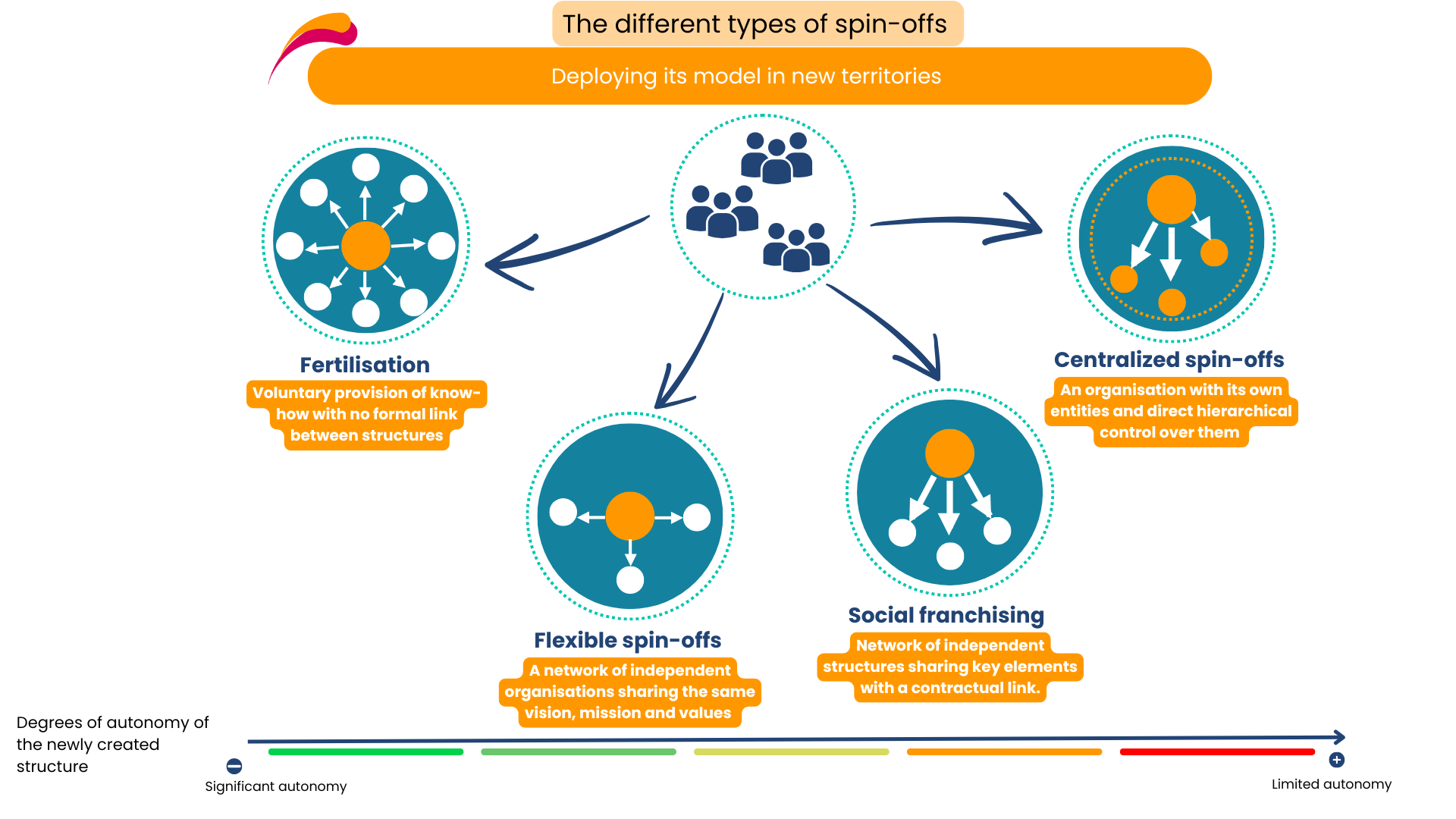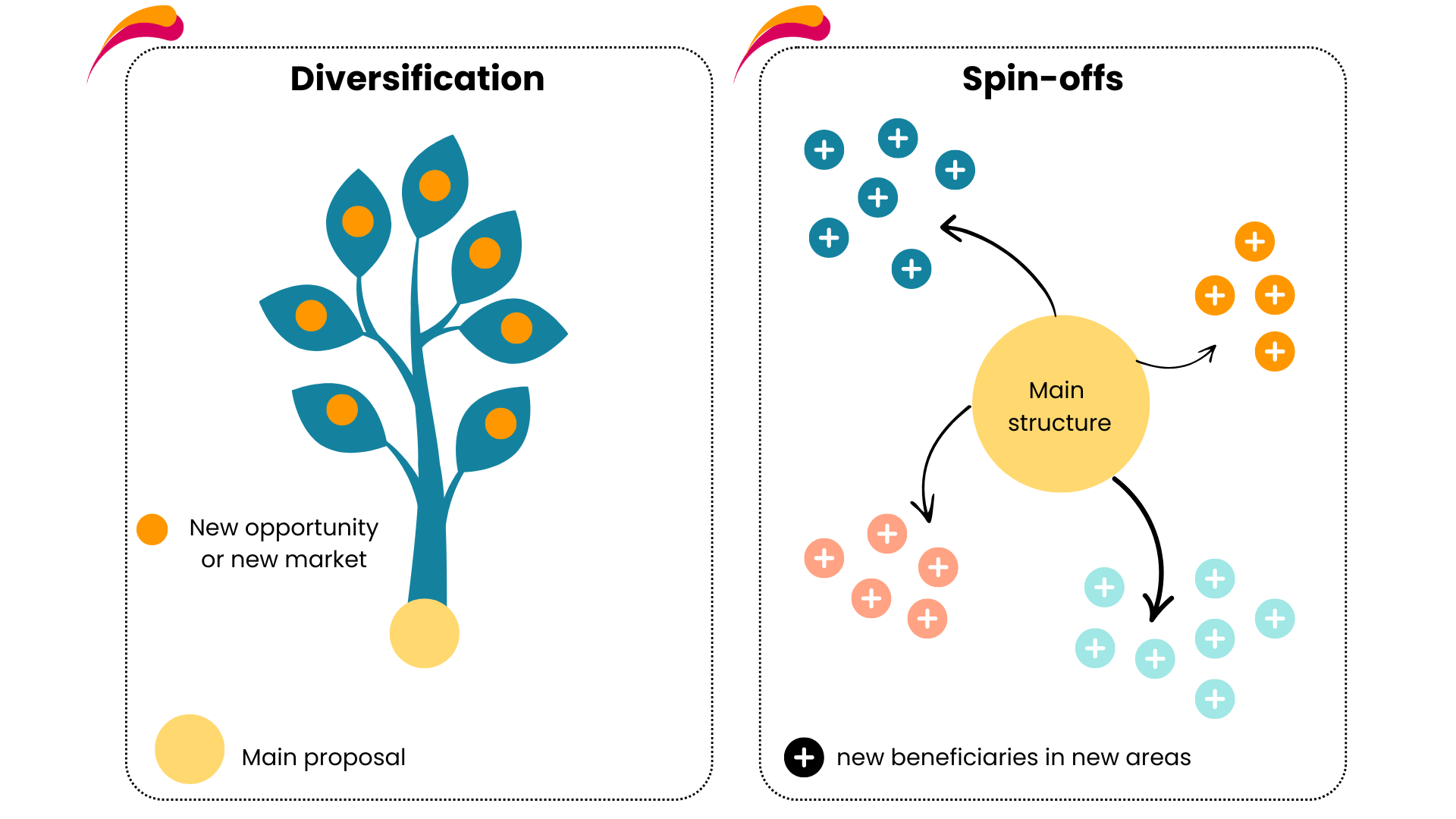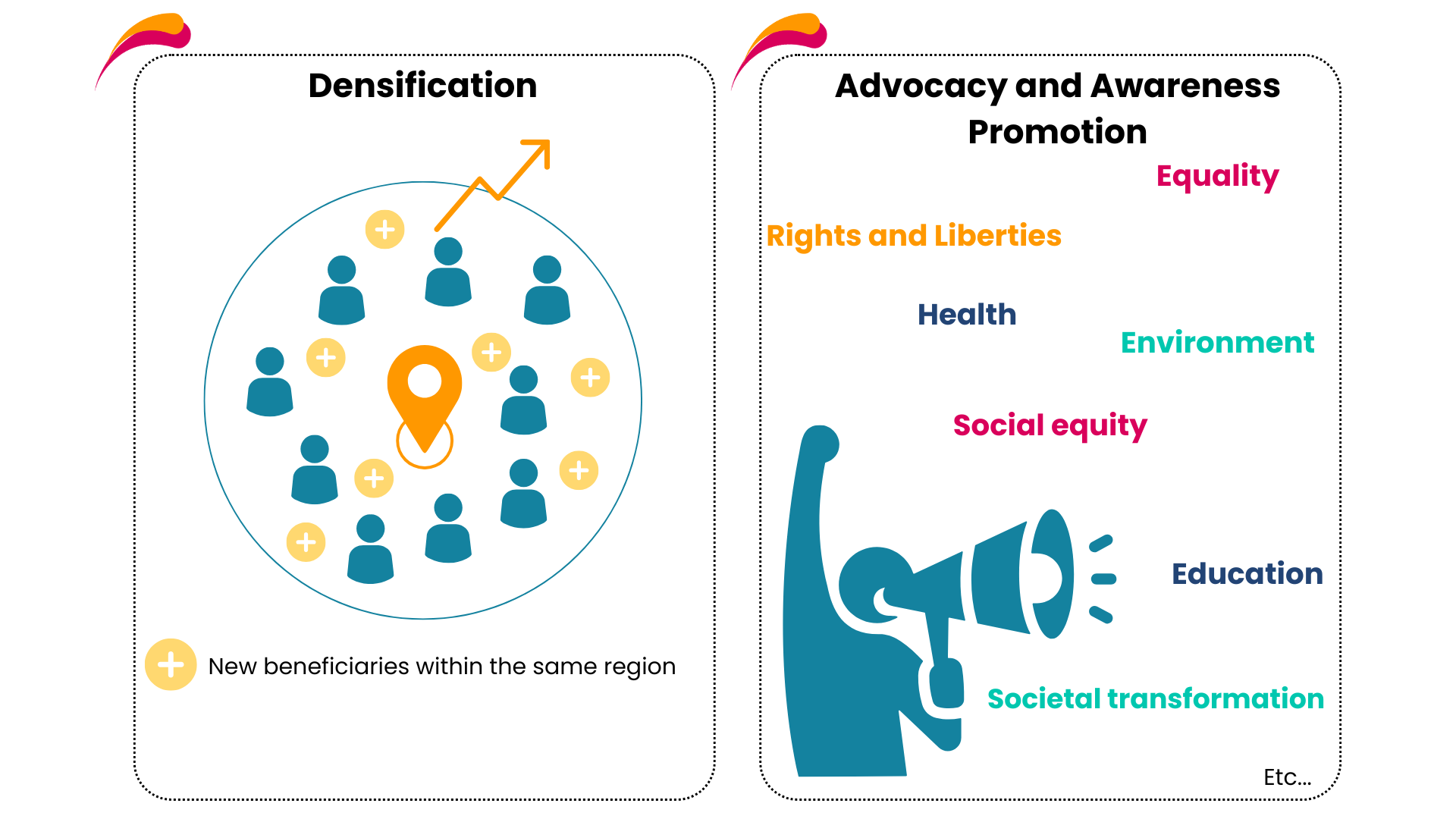The different strategies for scaling up

1. What does scaling up mean ?
Scaling up refers to a process whereby an organisation seeks to sustain and increase the impact of the solution it has developed. An organisation can decide to scale up for various reasons: to respond better or more effectively to an identified need, to strengthen or ensure the sustainability of its model, to change attitudes and standards, etc.
In all cases, scaling up requires a clear vision in order to achieve the ambition set, as well as a defined strategy for its operational implementation.
In this article, we explore the strategies and sub-strategies that organisations can opt for when they wish to increase their impact. We will decipher the specific characteristics of each of them and share concrete cases and examples.
2. The main scaling strategies
Multiple scaling strategies exist and none of them are exclusive. The important thing is to know when one strategy is more relevant than the other, rather than trying to implement several of them at the same time.
Here are the main strategies for scaling up your impact.
2.1 Diversification
Diversification is when an organisation broadens its offer or market by developing new products or services.
To illustrate the different diversification sub-strategies, let’s take the example of an association that fights against food waste by distributing foodstuffs. Below are the options:
- Reach new types of customers/beneficiaries with the existing offer/activities,
Example: The association, which specialises in food redistribution to combat food waste and poverty, has set up joint purchasing groups. Initially based in priority neighbourhoods, the concept evolved to target students through the setting up of distribution points on campuses.
- Develop new offers/activities for its current beneficiaries/customers,
Example: The association may decide to diversify its activity by collecting unsold food itself and redistributing it to people in need, or, instead of relying solely on donations from supermarkets and producers, the association may decide to set up its own farm or solidarity garden to produce some of the fruits and vegetables it distributes.
- Reaching new types of beneficiaries through new activities/offers.
Example: The association decides to set up a social integration business specialising in recycling and recovering bio-waste. This new activity is in a different sector of activity, but it remains consistent with the overall mission of the organisation to combat waste and preserve the environment.
Expected benefits:
✅ Greater financial strength with new sources of income
✅ Increased social/environmental impact by covering previously unaddressed needs or reaching a new audience.
✅ A lower dependence on a specific market or partners.
2.2 Spin-offs
Spin-off is a scaling-up strategy that aims at deploying its model (or part of its model) in other areas to reach more people.
Expected benefits:
✅ An opportunity to address an uncovered demand and therefore a new target of beneficiaries
✅ Access to new markets and therefore new sources of revenue
Fertilisation
Fertilisation consists in disseminating your know-how to independent players with no formal links with the parent organisation. This transfer of your approach can be done in a very open way (through your website for instance) or through contracts that provide a legal framework for the transfer.
Example: La Fresque du Climat (the climate fresco) shares its know-how via its website, with guides, videos and certified training courses so that people can become a facilitator. This method enables for the expertise to be passed on independently.
Flexible spin-offs
This is a network of independent organisations sharing a common charter defining common values, a common mission and principles of action. These organisations retain management autonomy while remaining aligned with the movement’s founding principles.
Example: Emmaus (solidarity movement fighting social exclusion) is developing a network of autonomous local associations offering different activities while retaining and applying the key values of the Emmaus association (e.g. Emmaus Connect, Emmaus Alternatives).
Social franchising
When an organisation develops a social franchise, it seeks to spread its model via a network of independent organisations that share a common charter, brand and methods, often framed by a contract that specifies the responsibilities and roles of the parties involved. Monetary contributions or fees may be required to share and value the costs associated with R&D, expertise, knowledge, etc.
Example: The association Toit à Moi (roof of my own) , which helps people living on the margins of society to make lasting changes to their lives, is spreading throughout France in the form of branches or social franchises.
Centralised spin-offs
This is when a structure deploys branches in new territories. These branches remain under the control of the parent organisation, guaranteeing a uniform strategy.
For example: Cami Sports & Cancer, which develops therapeutic physical activity programmes to enable cancer patients to receive treatment to limit the undesirable effects of treatment, improve their chances of remission and their quality of life, is being rolled out via its own network of branches.
2.3 Densification
Densification means reaching out to more people without expanding geographically, but by concentrating the organisations’ efforts in the same area.
Examples of densification:
- Increasing the frequency of services
- Improving the quality of existing services
- Developing local partnerships
- Using digital channels to widen access to services
Expected benefits:
✅ Cost efficiencies through economies of scale
✅ Greater social and environmental impact
✅ Stronger organisation thanks to improved tools, communication, and internal strategy
How do we go about it?
- Encourage word-of-mouth and referrers
- Adapt digital tools
- Strengthen communication strategy
2.4 Advocacy / awareness-raising
Informing, educating and encouraging the players in an ecosystem to adopt responsible practices are all levers that can be activated to increase impact. Advocacy and awareness-raising are not a strategy in themselves, but they can be one lever among others. Many organisations already carry out advocacy or awareness-raising without necessarily making it a central strategy for them. For some organisations, advocacy becomes a core strategy with, for example, a real objective of changing the law.
Example: Unis-Cité, a pioneer of Civic Service in France, has developed a model of civic engagement that encourages young people to get involved in responsible projects centred on the environment and solidarity.
Expected benefits:
✅ Greater social/environmental impact
✅ Increased brand awareness
✅ Partnership opportunities
✅ Acceleration of regulatory changes
How can we proceed?
- Communication campaigns
- Workshops and training
- Organisation of public events
- Partnerships with local businesses
- Petitions and advocacy
3. Visual summary
To find out more
📙 Our previous article on scaling up
📙 Structures supported by ScaleChanger as they scale up
Are you facing the challenge of scaling up and would like some support? Contact us 👉 contact@scalechanger.org
Date: 31 March 2025




